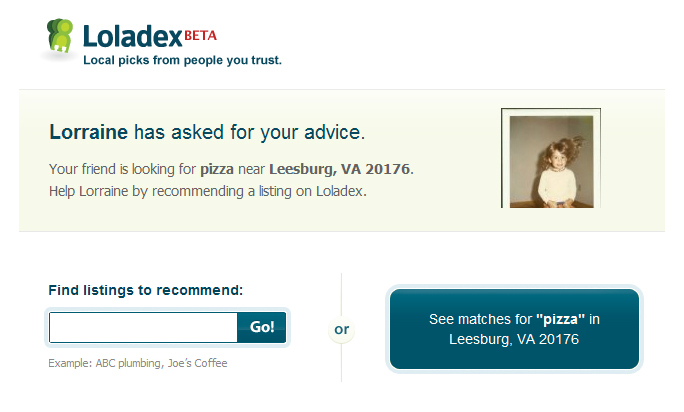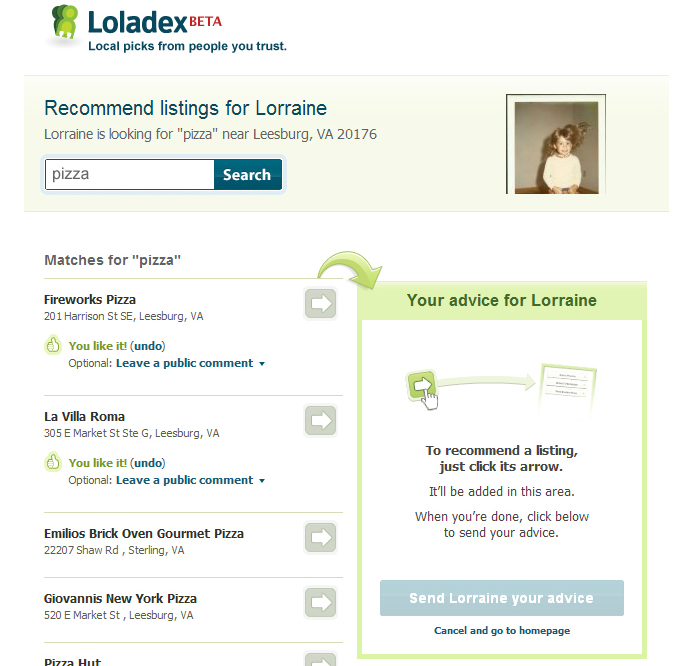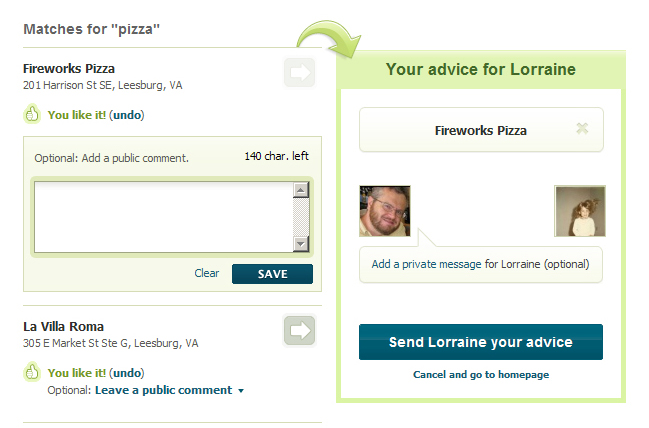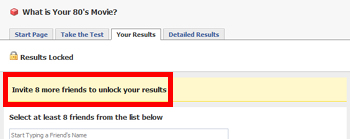by Laurence | Aug 15, 2011 | Loladex

OK, first some background.
People like to ask for recommendations on Facebook. This was becoming evident in 2008; by now it’s entrenched behavior. Mostly people ask via their status. Last month, for instance, my sister asked:
Need recommendations for semi-foodie restaurant in NYC that a chef would like.
She quickly got a bunch of referrals from her friends, including a recommendation for a nice place called Dell’Anima.
Such exchanges happen countless times each day on Facebook (and on Twitter, and elsewhere), and they usually work quite well. But from where I sit, they also leave unfulfilled opportunities.
- First, an opportunity to enrich the current interaction. My sister’s friends made their recommendations via plain old typing, without tags or links, so Facebook didn’t “know” that Dell’Anima is a restaurant. As a result, it didn’t provide a phone number, a star rating, a Web site, reservations on OpenTable, or even just the relevant Facebook page for Dell’Anima. Nor did it provide social context: Some of my sister’s other friends might already have “liked” Dell’Anima elsewhere, which would help her decide.
- Second, an opportunity to enrich future interactions. Unstructured recommendations just float off into the ether after they’re read. If another friend asks the same question tomorrow, the person who recommended Dell’Anima will have to type the same answer all over again. Instead, shouldn’t her recommendation be saved and then displayed to her friends in other contexts, without any work by her?
Facebook has economic reasons to address these needs, and it’s started to do so. It’s trying to add structure by suggesting tags as I type, for example; presumably its suggestions will get better once it can analyze the meaning of my words in real time.
And Facebook still owns everything I’ve done on the service, so maybe I’ll wake up tomorrow and it’ll have extracted, retrospectively, every restaurant recommendation I ever made. Then it could offer to “like” all those places for me.
I’d welcome that, if it worked properly.
Back in 2008, though, recommendations weren’t high on Facebook’s agenda. The plan was — my plan was — that users would share advice via a structured application, not via comments. A “Recommendations” app could ultimately become part of the standard Facebook suite, like Questions is now.
The approach wasn’t crazy then, and it still could be viable today. But it presents a challenge, since using an app will always be harder than typing “Dell’Anima FTW.”
So, back in 2008, here is how we tackled it.
Your friend wants advice: She needs to find a local place that serves good thin-crust pizza. Ideally you see her question in your own news feed, but maybe you get an e-mail or see a Facebook notification (screengrab at top of this post).
Whatever the prompt, we want you to click into the Loladex application. Assuming you’re already a Loladex user (which is a whole other topic), this is what you see next —

(I’m omitting the Facebook stuff that surrounds the app.)
Some good things about the page above: It shows your friend’s name and Facebook photo, which makes this a personal interaction; it recaps the question; it looks nice.
Not so good: It requires an immediate choice between two paths, and we don’t explain the options very well. If we stuck with this approach, better language might have been:
Recommend a business by name, with a button that says “Find“; or
See all matches for “pizza” near Leesburg, VA 20176
Also, it should include the additional info your friend provided: She’s looking for thin-crust pizza.
But actually, we probably should have skipped that landing page entirely and combined it with the next page, which looked like this —

In the listings on the left, anything you’ve previously liked is at the top, since that’s what you’re likely to recommend. (Note: At the time you couldn’t “like” regular businesses on Facebook itself.)
Our aim here was to mimic real-life advice, where people bundle several suggestions and add commentary: “ABC is awesome, but doesn’t do thin-crust. XYZ is a hike, but has excellent thin-crust.”
Hopefully the model is clear: Click the arrow to add each business to your recommendation. After adding a business the page looks like this (just the relevant part shown) —

Anything you write on the right-hand side is between you and your friend. You can delete a business from your recommendation by clicking the “X.”
On the left-hand side, you can add public comments about each place you’ve recommended. Note the 140-character limit on public comments: I’m a believer in such limits, but 140 was just trendiness. 200 would have been better.
I believe that recommending a place also automatically “liked” it, and that you could undo the “like” without undoing the recommendation.
And that’s basically it. Add a note, click to send.
A side question: Should the interaction be private, as shown here, or visible to all friends so they can chime in? In 2011 the instinct is to make it all a quasi-public discussion, but in 2008 we worried about scenarios: Pizza restaurants are fine, but what if you were recommending a doctor and wanted to add a note about your own experience?
In the next post: How users asked for recommendations on Loladex.
by Laurence | Aug 12, 2011 | Loladex
I made peace long ago with the ephemeral nature of online products. Unlike some folks, I don’t routinely keep archives of what my various Web sites used to look like — though I do sometimes visit the Wayback Machine to refresh an imperfect memory.
Loladex was different, however, and I did take some screenshots before it shut down. I had a few reasons:
- For better or worse it was my site, more than anything else I’ve worked on.
- I knew the Internet Archive wouldn’t work because (among other things) Loladex required a logged-in state on Facebook plus dynamic searches of licensed data.
- I wanted a record of the UI solutions we created, so that I could improve on them in future products.
This post is first in a series that’ll discuss & illustrate the features of Loladex that I think are still relevant today. In all cases the UI is a work-in-progress, frozen now in time. We learned many lessons, but I’m certain we ended far from an optimal solution — if such a solution even existed.
Before I start that, however, here’s some catch-up on Loladex.
Loladex launched in spring 2008. It was a Facebook application, meaning it was accessed via Facebook.com by users who had signed in. With the exception of games and Facebook-run applications, this approach is mostly passé now.
Loladex allowed you to find local businesses — restaurants, plumbers, psychiatrists — that had been recommended by your friends. If none of your friends had already recommended, say, a plumber, you could ask them to do so.
A true online equivalent to word-of-mouth recommendations: It’s not an original idea, but in 2008 no one had made it work yet.
And indeed, that’s still the case in 2011.
In the next post: How users made recommendations on Loladex.
by Laurence | Dec 13, 2008 | Loladex
A friend of Loladex called this hibernation, since it occurs in a wintertime both actual and metaphoric, but really I hope the right image is a chrysalis.
Either way, here’s the fact: Loladex is suspending operation of its Facebook application for several months while we work on a new approach.
If you’re a Loladex user, I apologize for the inconvenience. As things progress, we’ll keep you informed in two ways:
• Via this blog
• Via a direct message when we re-emerge
If you have comments or questions, please post them below. I’ll respond to everyone.
by Laurence | May 25, 2008 | Local search, Loladex
Via Andrew Shotland, I recently saw this post. I know I’ll be called naive, but I was surprised at its blatancy.
This guy Stephen Espinosa (whom I don’t know) helps local businesses promote themselves online. His advice is to get your “clients” to post reviews on popular sites — the quote marks are his, and he adds a smiley face in case we don’t get it:

I won’t spell it out fully, since he doesn’t, but this seems like an opportune moment to talk about fake reviews.
You need spend only a few minutes on most rate-and-review sites to understand that they contain fake reviews. There are fake positive reviews posted by the business owners, and fake negative reviews posted by their competitors. Many are amateurish and easy to identify if you’re looking for them, though I suspect that some casual users don’t realize they’re fake.
I’ve never put much store in reviews by strangers. Still, I always thought that out-and-out fakes were a fairly limited and unorganized phenomenon. Now that I see they might be promoted more systematically, I’ve lost confidence that I can even spot a fake.
Furthermore, I expect that such fakery will spread and become more sophisticated. As local search reaches critical mass, it’ll be hard to trust anything.
I used to believe, for instance, that a Yelp reviewer with 10+ reviews and some kudos from friends was almost certainly a real person. That’s probably still a safe assumption — but will it be next year?
If I’m a certain type of SEO consultant, right now I’m probably setting up a network of hundreds of fake Yelpers. They’ll all have real-looking pictures, real-sounding profiles, and lots of reviews (some even genuine). They’ll send each other kudos, enhancing each others’ credibility.
And they’ll exist solely so I can be paid to deploy them for the benefit of my clients.
If done properly, this sort of fakery will be very hard to detect. Probably the only way I’d get caught would be to advertise the service — or to include quote marks and smiley faces when I blogged about it.
And this is just the truly fake reviews. There’s still reviews from friends of the business owner, and “real” reviews that have been solicited directly by business owners, some of whom will give discounts in exchange for posting on … well, on a certain site.
In such a world, reviews by strangers become devalued and personal trust is at a premium.
Not so long ago I heard that we need to see, on average, 20 reviews from strangers before we’ll believe the prevalent opinion that’s being expressed.
What will that number be in the future? 50? 100?
Wouldn’t it be simpler and better to get your advice from people you know and trust?
Via, say, Loladex?
by Laurence | May 25, 2008 | Loladex, Social search
My previous post was about why you’d want to use Loladex. This post is about the nitty-gritty of getting people to do so.
Fair warning: If you don’t care about the inner workings of Facebook, this may not fascinate you.
OK, so we have this Loladex product. Among other things, it allows you to ask your friends for advice on local businesses. You might need help finding a good electrician, for instance.
Because Loladex delivers advice from your friends, it works best when it’s hooked into a social network. And among the social networks, we like Facebook best: It’s unmatched in its combination of audience size, integration tools, and viral channels.
So we launched Loladex on Facebook.
And two months later we still like Facebook. But …
But even on Facebook, our users can’t be fully social. And therefore they can’t get the full benefit of Loladex. It’s harder than I’d like, for example, to ask my friends if they know … well, a good electrician.
This isn’t just a problem for us. It’s Facebook’s problem, too, because real-life applications like Loladex are what Facebook needs in order to build long-term relevance.
So far our biggest issues have been:
- Facebook’s lack of clarity about how its own systems work; and
- The poisoned atmosphere that’s been created by many Facebook applications.
First, lack of clarity about Facebook’s internal workings.
For sure, this is partly our own fault. We’re still climbing the Facebook learning curve. Sometimes we just don’t know where to look for information.
Also, Facebook is a young company, moving quickly and constantly changing its own rules. It’s just about to launch a big redesign, for example, and we don’t really know how it’ll affect us. We accept that.
But Facebook makes things worse by being deliberately mysterious about some of its key features. A classic example is the News Feed that appears on everyone’s Facebook home page.
If you’re a Facebook user, you’re familiar with the News Feed: It shows you what your friends have been doing and saying on Facebook, and sometimes on other sites too. In an ideal world, Loladex could use it as a reliable communication channel.
The thing is, your News Feed shows only a small slice of your friends’ activity. Facebook decides which items will (and won’t) be displayed. It does so the same way Google assembles its search-results pages — via an algorithm that it changes often and will describe only vaguely.
There’s a reason for this, of course. Like the Google search-results page, the News Feed is valuable real estate. Publish an exact formula and it’ll be abused by spammers and others.
Still, the secrecy means we must work within an uncertain system. We follow Facebook’s guidelines, but often it doesn’t help. So we dive into the many long, geeky Facebook discussions that have flowered across the Web. Some tips are helpful, others are either outdated or wrong.
Sorting through all this vague and unreliable information is a time drain for Loladex. Experimenting with different methods, even more so. But both are necessary, unfortunately.
To complicate mattters, it’s tough to know when we’ve solved a problem. Unlike Google, where everyone sees the same search-results page (more or less), everyone’s News Feed is different. Even when something seems to work, it may not be working for everyone.
OK, now for our second big issue: The bad faith of many Facebook applications.
Simply put, Facebook’s utility is being crippled by all the dumb, spammy and downright abusive applications it enables. See below for a typical example of how such applications spread:

These black hats make it difficult for Loladex to build a white-hat application, for at least two big reasons:
- Rather than making communication easier among its users, Facebook has been making it harder. It has tried to devise formulas that’ll penalize only “bad” applications, but everyone gets snagged to some degree.
- Because of the ongoing torrent of crap, some Facebook users have stopped clicking any buttons that might send a message to their friends. Many also ignore every single invitation they get. Or if they add an app, they disable the very communication features that’ll make it work properly.
The net effect is a big damper on Facebook’s potential, and a tougher task for Loladex.
I remain a fan of Facebook, but I’m not sure it understands the depth of its problem here. I’m reminded of when AOL was reviled for assaulting its users with pop-up ads. Eventually management shut them down, but it took too long and there were too many half-measures along the way. AOL was definitely hurt; arguably, it never recovered.
So what’s to be done? How do we overcome these issues so that Loladex users can get the most from Facebook?
In the short run, we’re working on our own solutions. I’ll blog about them as we roll them out in the coming weeks.
In the medium run, though, I believe Facebook must make some changes.
Specifically, Facebook must start discriminating between applications — and not just via its algorithms, a tactic that ultimately punishes its users. Besides policing bad apps, Facebook should be using human beings to identify and favor applications that can be useful in people’s regular lives, because their growth is in the company’s strategic interest.
Exactly how to favor such apps is up to Facebook. I would suggest easier access to the News Feed and a more prominent “request” mechanism, achieved via clear procedures that don’t need to be secret because they’re open only to approved applications.
Whatever the method, it’d be refreshing to see Facebook focus once again on making communication easier — not on shutting it down.
In this vein, there have been rumblings lately, apparently false, that the company might add a “preferred developer” or “preferred application” program. I would welcome such a program, and I’d happily pay to participate.
If I were Facebook, I’d make it work something like this:
• Applications must fall into categories that are judged to be strategic to Facebook. The list of categories could start small & be expanded.
• Applications must have existed for X weeks, and during that period must have met minimum standards for non-spamminess.
• Applications must follow all of Facebook’s rules and recommended practices. (Facebook should be documenting more of these rules and practices.)
• As a token of their seriousness, developers pay an upfront fee to participate. In return, Facebook gives them an equivalent advertising credit.
• Developers include a prominent, standardized way for users to complain to Facebook, which hires user advocates to field these complaints. The process should be human: If developers don’t work in good faith to fix problems, the advocates may yank their privileges.
• Approved applications are clearly identified as “safe” by Facebook to its users.
The exact mechanics don’t matter, however. The main thing is, this requires human intervention. Facebook can’t rely on statistics alone to recognize and promote the applications that will turn it into a fully functioning community.
Which categories and applications should be promoted? Again, that’s up to Facebook. I don’t know what they’re aiming for, but I’m pretty sure they can’t be thrilled with the current mix, or the resulting assessments of their platform.
In any rational process, I’m confident that applications such as Loladex will be part of the solution. As such, they should get more help than, say, Vibrating Hamster — which may be a part of the solution itself, I suppose, but for an entirely different problem.
by Laurence | May 21, 2008 | Competitors, Local search, Loladex, Social search
Why would anyone start using Loladex? We get asked this question a lot.
I’ve posted before about the chicken-and-egg issue, albeit in general terms. Probably I should update those thoughts: Since we started focusing on social networks, we’ve learned a bunch.
But for now, let me address Loladex’s specific challenge: How do we motivate people to rate local businesses via a Facebook application? Why would anyone do such a thing?
Well, for many reasons, of course. One day I’ll list them all. But I’d like to highlight one reason in particular, partly because I think it’s powerful and partly because it illustrates a big difference between Loladex and two of its biggest competitors — Yelp and Angie’s List.
Here it is: Loladex believes people will rate local businesses to help their friends.
By friends, I mostly mean actual, real-world friends. People you might have dinner with. For most folks, that’s a subset of “Facebook friends.”
Let’s get specific. Why would anyone use Loladex to rate, let’s say, a plumber? Or a pediatric gastroenterologist? Certainly it’s not something you do on a whim. Loladex won’t be running ads that say “Rate pediatric gastroenterologists!” — and if we did, we wouldn’t expect many clicks.
But suppose you were asked directly by a friend whose kid needed a medical specialist? If you knew of a good gastroenterologist, would you take a minute to make the recommendation? If you were seeking such a specialist, would you value this sort of recommendation?
We think so. Such recommendations are an everyday part of friendship, and numerous surveys tag them as a more powerful force than the Yellow Pages, a $14 billion industry.
With Loladex, we want to provide a channel for these person-to-person recommendations.
Contrast this to Yelp. I always say I like Yelp — and I do — but Yelp isn’t about helping your real-world friends. By and large, the people who rate businesses on Yelp do it for reasons of (a) self-expression; and (b) social standing in an online community that may overlap with their real-world friends, but doesn’t have to.
These mostly twentysomething Yelpers provide a service for us all, God love them. But it’s almost never a person-to-person transaction. Also, the motivation to rate something on Yelp fades quickly outside its core realm of restaurants & other social venues.
Or consider Angie’s List. I’m not a fan of Angie’s List, simply because it’s a subscription service. If it were free, I’d love it. They’ve built something that’s clearly valuable to their users — and they’ve focused their brand admirably, defining it around home services.
Again, though, Angie’s List isn’t about helping your real-world friends. It’s mostly a community of cooperating strangers who share ratings because they understand the value of the site’s virtuous circle. There’s an implicit quid pro quo.
Both Yelp and Angie’s List have powerful models. Loladex aims to tap many of the same motivations; we’d be silly not to. But mainly we’re about recommendations from your friends. We’re trying to bring this everyday personal interaction into your online world.
OK, so much for the theory. How’s the “help a friend” strategy working for us, specifically on Facebook?
To be honest, it’s a learning experience.
More in Part 2.





